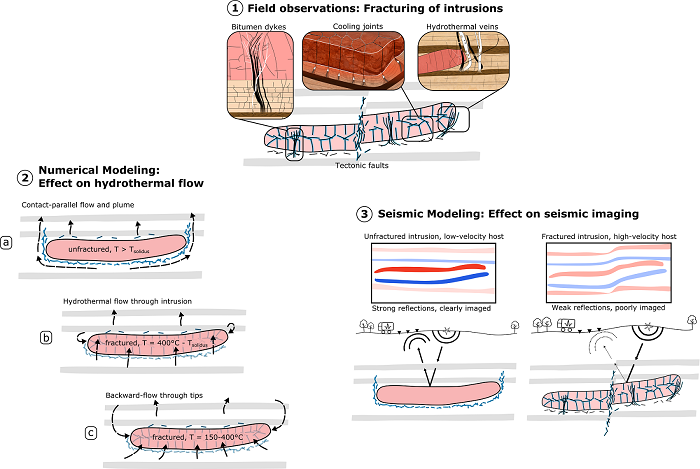The PhD defence and trial lecture are fully digital and streamed using Zoom. The host of the session will moderate the technicalities while the chair of the defence will moderate the disputation. It is possible to be present at the disputation in auditorium 1.
Trial lecture
15.10.2021, 9:00 AM, Auditorium 1, The Geology Building and digitally at Zoom:
Tectonic inversion in sedimentary basins
Conferral summary (in Norwegian)
Magmatisk smeltemasse som trenger inn i organisk rik skifer utløser danning av hydrokarboner og hydrotermisk strømning i jorden. Dette kan føre til utslipp av store mengder av klimagassen metan til atmosfæren, men også til danning av olje- og gass. Avhandlingen karakteriserer sprekknettverk i magmatiske intrusjoner, og viser at de i stor grad kan påvirke hydrotermiske strømninger og transport av hydrokarboner knyttet til intrusjoner. I tillegg viser doktorgradsarbeidet hvordan seismisk modellering kan forbedre seismisk tolkning av intrusjoner i ulike geologiske omgivelser.
Main research findings
Popular scientific article about Rabbel’s dissertation:
Fracturing of igneous intrusions emplaced in organic-rich shale: Implications for hydrothermal flow, petroleum systems and exploration in volcanic basins
Hot igneous intrusions entering organic-rich shale trigger hydrocarbon generation and hydrothermal flow. This may release large quantities of methane to the atmosphere, causing global climate crises, or alternatively form petroleum accumulations. Fracturing in and around magmatic intrusions influences subsurface permeability and thus hydrothermal flow and hydrocarbon migration in these systems. However, fracturing processes of igneous intrusions and the surrounding host rock are still poorly understood.
This doctoral thesis combines fieldwork, numerical modeling, and seismic modeling to improve our understanding of how fractures evolve within igneous intrusions and their host rocks, and how this impacts subsurface hydrothermal flow patterns. A key finding is that fracture networks of shale-hosted intrusions can be substantially more variable than previously thought. These fracture networks can become accessible to hydrothermal fluids and hydrocarbons while intrusions are still extremely hot, leading to graphitization of hydrocarbons at 350-400°C or more. Lastly, seismic modeling results demonstrate that fracturing, igneous rock type and host rock variability may cause seismic reflections from intrusions to vary between strong reflections to transparent. This finding is important because seismic data play a key role in the identification and characterization of subsurface igneous intrusions.

Photo and other information:
Press photo: Ole Rabbel, portrait; 500px. Photo: Private
Other photo material: Figure with description and credit as specified in the article above, size 1700px.
